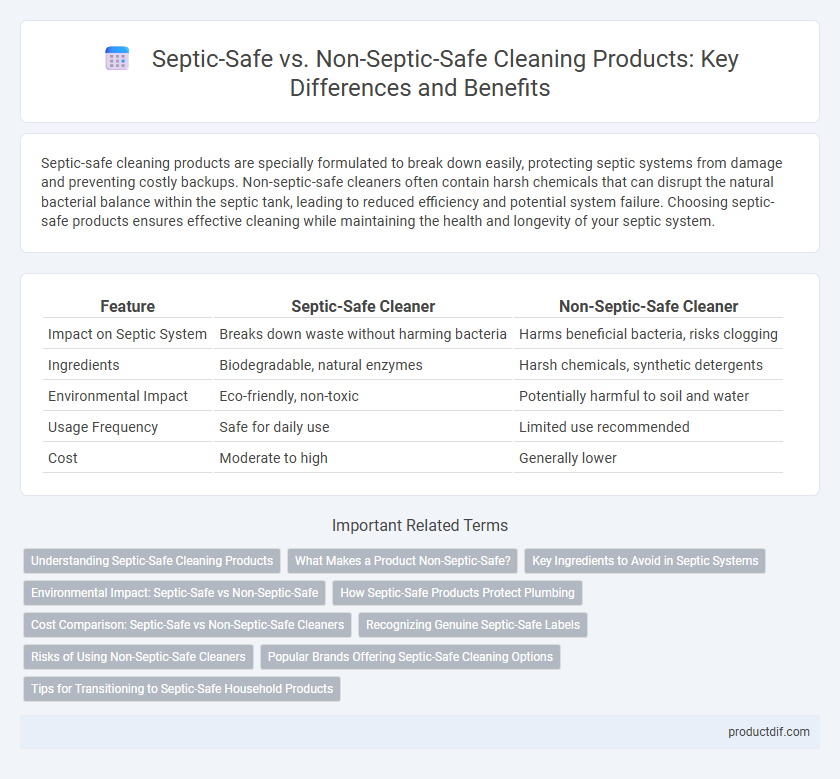Septic-safe cleaning products are specially formulated to break down easily, protecting septic systems from damage and preventing costly backups. Non-septic-safe cleaners often contain harsh chemicals that can disrupt the natural bacterial balance within the septic tank, leading to reduced efficiency and potential system failure. Choosing septic-safe products ensures effective cleaning while maintaining the health and longevity of your septic system.
Table of Comparison
| Feature | Septic-Safe Cleaner | Non-Septic-Safe Cleaner |
|---|---|---|
| Impact on Septic System | Breaks down waste without harming bacteria | Harms beneficial bacteria, risks clogging |
| Ingredients | Biodegradable, natural enzymes | Harsh chemicals, synthetic detergents |
| Environmental Impact | Eco-friendly, non-toxic | Potentially harmful to soil and water |
| Usage Frequency | Safe for daily use | Limited use recommended |
| Cost | Moderate to high | Generally lower |
Understanding Septic-Safe Cleaning Products
Septic-safe cleaning products are specifically formulated to break down quickly and contain biodegradable ingredients that support the natural bacteria in septic tanks, preventing clogs and system damage. Non-septic-safe products often include harsh chemicals, such as chlorine, phosphates, and antibacterial agents, which can disrupt the bacterial balance essential for waste decomposition. Choosing septic-safe cleaners ensures system longevity, reduces maintenance costs, and protects the environment by minimizing harmful runoff.
What Makes a Product Non-Septic-Safe?
Non-septic-safe cleaning products contain harsh chemicals, such as chlorine bleach, ammonia, and phosphates, which disrupt the natural bacteria essential for breaking down waste in septic systems. These substances can cause damage to septic tanks, leading to blockages, reduced bacterial activity, and costly repairs. Using biodegradable and enzyme-based cleaners minimizes the risk of harming septic tank functionality and supports long-term system health.
Key Ingredients to Avoid in Septic Systems
Septic-safe cleaning products avoid harsh chemicals such as bleach, ammonia, and phosphates, which can disrupt the natural bacteria essential for breaking down waste in septic systems. Enzymatic and biodegradable ingredients help maintain the balance within septic tanks, preventing clogs and costly repairs. Non-septic-safe products often contain synthetic fragrances and antibacterial agents that kill beneficial bacteria, compromising system efficiency and longevity.
Environmental Impact: Septic-Safe vs Non-Septic-Safe
Septic-safe cleaning products contain biodegradable ingredients that break down easily and prevent harmful buildup in septic systems, reducing groundwater contamination. Non-septic-safe cleaners often include harsh chemicals like phosphates and ammonia, which disrupt septic bacteria and can lead to costly system failures and environmental pollution. Choosing septic-safe products supports sustainable waste management and protects aquatic ecosystems from toxic runoff.
How Septic-Safe Products Protect Plumbing
Septic-safe cleaning products use biodegradable ingredients that break down quickly, preventing harmful buildup in septic tanks and maintaining efficient waste decomposition. These products avoid harsh chemicals that can kill essential bacteria, ensuring the natural septic system processes continue unhindered. Protecting plumbing through septic-safe formulations helps prevent pipe corrosion, clogs, and costly repairs by supporting a balanced and healthy septic environment.
Cost Comparison: Septic-Safe vs Non-Septic-Safe Cleaners
Septic-safe cleaners typically cost more upfront than non-septic-safe alternatives due to their biodegradable and enzyme-based formulas designed to protect septic systems. Non-septic-safe cleaners are often cheaper but can lead to costly septic tank damage and maintenance over time. Investing in septic-safe products reduces long-term expenses by preventing system clogging and preserving bacterial balance essential for septic function.
Recognizing Genuine Septic-Safe Labels
Recognizing genuine septic-safe labels involves checking for certifications from authoritative bodies like NSF International or the Environmental Protection Agency (EPA) that specifically indicate compatibility with septic systems. True septic-safe products are formulated to break down easily without harming the beneficial bacteria essential for wastewater treatment. Avoiding products without clear septic-safe labeling helps prevent system clogs, costly repairs, and environmental contamination.
Risks of Using Non-Septic-Safe Cleaners
Non-septic-safe cleaners contain harsh chemicals that can disrupt the natural bacterial balance essential for efficient waste breakdown in septic systems. Using these products increases the risk of clogged pipes, system backups, and costly repairs due to impaired bacterial activity. Septic-safe cleaners ensure the longevity and proper functioning of septic tanks by preserving beneficial microorganisms and preventing damage to the system.
Popular Brands Offering Septic-Safe Cleaning Options
Popular brands like Seventh Generation, Mrs. Meyer's, and Method offer septic-safe cleaning products formulated to break down easily and prevent system clogging. These products typically avoid harsh chemicals, ensuring safe interaction with septic tanks and maintaining bacterial balance essential for efficient waste decomposition. Choosing septic-safe options from trusted brands helps protect septic systems and reduces costly maintenance or repairs.
Tips for Transitioning to Septic-Safe Household Products
When transitioning to septic-safe household products, choose biodegradable cleaners free of harsh chemicals like phosphates and chlorine that can disrupt septic tank bacteria. Gradually replace non-septic-safe products with enzyme-based or plant-derived alternatives to maintain the natural bacterial balance essential for proper septic system function. Regularly monitor septic tank health and schedule professional inspections to ensure the system adapts effectively to new cleaning routines.
Septic-safe vs non-septic-safe Infographic

 productdif.com
productdif.com